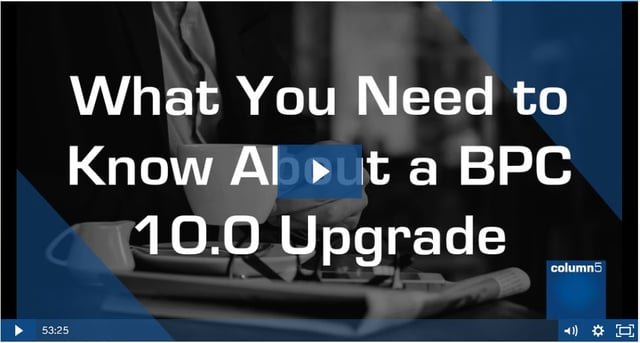
“What is your BPC upgrade strategy?” or “what is the best plan to migrate BPC?” are the most common questions I am asked by clients looking to upgrade to the latest version of SAP BPC. Even though clients' landscapes come in all shapes and sizes, the overall strategy for a BPC upgrade is not very different from one client to the next.
We’ve had clients that started out with OutlookSoft, upgraded to version 7.5, and still have EVEXP and EVGTS/EVGETs along with EVDRE style reports when they decide to move to EPM10. Some clients have even started out with the Microsoft version and then elected to move to NetWeaver. An effective upgrade strategy is necessary to ensure that all objects are upgraded properly, the system is stable, and the upgrade causes as little interruption as possible to business as usual.
For new clients that wish to upgrade to EPM10 I recommend the following:
Assess your current state through an EPM Assessment:
- An upgrade is the perfect catalyst to review the overall EPM strategy of your organization, determine what enhancements can be incorporated into the environment as part of an upgrade, investigate lingering pain points of the existing system, and do a deeper dive into the current configuration, from both a functional and technical perspective. By doing this, the team will have a better understanding of the upgrade effort, point out potential upgrade ‘gotchas’, and assemble an overall upgrade path.
Partner with Column5 Technical Services for a Landscape Design, installation, tuning, and support:
- A properly sized and designed infrastructure is the foundation for a well performing and stable environment. Column5 Technical Services will analyze requirements and usage models to develop sizing requirements, install necessary software to have your EPM10 environment run, migrate the existing BPC appset(s) to the new EPM10 environments, tune the production environment for optimal performance, and support issues which arise along the way and beyond.
Take EPM Academy Training:
- Training is available through the Column5 EPM Academy in order to ramp-up all of your core and end users in the EPM 10 interfaces via recorded, live, and custom training offerings. Delta courses are available to bridge the gap between version 10 and prior versions. Is it very important for all users to understand ways to properly use the new environment, especially as they move into the roll-out of the new system and user adoption.
Regression Test and Report Migration:
- The Column5 Functional Team will next perform regression testing activities and add additional functionality based on the EPM assessment. During regression testing, the Functional Team will ensure that dimensions render properly, logic packages validate and execute correctly, work status and security are updated, business rules migrate correctly, and the fundamental operation of the system remains intact. I’m often asked “what will break when we migrate?” While every client situation will vary, and regression testing of all objects is a must, here are a few general upgrade considerations:
- When staying within the same platform (i.e. MS to MS upgrade or NW to NW upgrade) script logic and business rules generally upgrade without much rework
- Business Process Flows need to be rebuilt in v10
- Dimensions and hierarchies generally upgrade without much remediation
- Drill Through parameters need to be modified
- Custom BADIs (NW Platform) have functions which need to be replaced for v10 and SSIS packages parameters need to be modified (or packages need to be rebuilt if going to a new version of SQL Server)
The migration from older reporting technologies like EVEXP and EVDRE to the EPM Add-in is a subject I often get questions on. Questions usually center on whether or not their existing reports will migrate correctly. While there is nothing cut and dry, here are some general observations when it comes to report and input schedule migration:
- In general, some existing EVDRE reports will migrate to the EPM Add-in correctly with some modification or by using the EPM migration tool for basic reports (though some clients elect to recreate these simpler reports with the EPM Add-in)
- As more advanced features of EVDRE are used, it may be more necessary to rebuild the template from scratch in the EPM Add-in in order to function properly and/or optimize performance. These may include the use of EVSUM, multiple key ranges, extensive use of before/after ranges, block suppression, advanced formatting, and/or multiple EVDREs working together in a report
- Some “EV” functions no longer work, but have been replaced with “EPM” formulas in version 10
- Additionally, here are some report migration approaches which have proven to be successful:
- Partner with the Column5 Functional Team to develop core reports in the EPM Add-In and then perform knowledge transfer to power users and report writers for system sustainability
- Utilize the Column5 Center of Excellence Development team to migrate reports in bulk to EPM 10
- If report creation and management are spread out among all users of the system, consider a sandbox environment (or a copy of the EPM DEV environment) for users to test their reports and get an indicator of what works and what does not. Assemble frequently asked questions and self-remediation guides
By following this general methodology for EPM upgrades, your environment will be up and running with as little interruption as possible. So make your BPC upgrade strategy, the Column5 BPC upgrade strategy!
WEBCAST ON-DEMAND: What You Need to Know About a BPC 10.0 Upgrade
Considering an upgrade to SAP Business Planning and Consolidation (“BPC”) version 10.0? Relevant for both Microsoft and Netweaver versions of BPC, this three part webcast series will dive deep into the topics that must be at the forefront of your mind when planning and executing the upgrade.
Related Content You Might Like:
Considerations in Upgrading to SAP BPC v10
Are You Ready for a BPC Upgrade
What Should an SAP BPC Team Look Like? Update!
Adam Schulang was the Director of Services at Column5 Consulting from 2007-2015.












